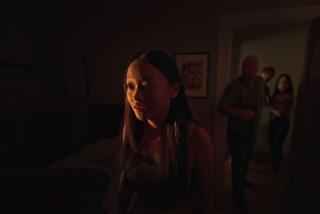Ghost Story : Spirit Seeker Claims Firm Destroyed a Haunting Videotape
- Share via
Casper’s life was never so complicated.
But then the ghost made famous in cartoons was never the object of a legal dispute between Hollywood producers and an independent filmmaker. In a case believed to be the first of its kind, Daniel Hobbit of Canoga Park is suing a Hollywood production company for $100,000, claiming the company damaged his videotape that captured what he says was not just a ghost, but a rare one at that.
“It was really one of a kind,” Hobbit’s attorney, Drew E. Pomerance, said of the tape. “It was highly unusual.”
Hobbit’s adventure with apparitions started nearly two years ago, when he was contacted by a Moorpark family with ghost problems.
For several years, the family had lived with inexplicable happenings: doors slamming, strange scents wafting from a china cabinet, the eerie voice of a crying woman and a dark, shadowy figure seen lurking in a bedroom, Hobbit said.
“Because they were afraid of ridicule--and didn’t know who to turn to--they lived with it,” Hobbit said. “For years, they didn’t even tell one another.”
Months before, Hobbit had joined forces with Beverly Hills psychic Nonie Fagatt to form the Light Brigade. Free of charge, the two would travel to places where ghosts were sighted and attempt to help wandering spirits “get to the other side,” Hobbit said.
“I was thrown into a whole other arena,” he said, “. . . going from videographer to ghost buster.”
Armed with a video camera, he and Fagatt went to the Moorpark house at the family’s request and spent several hours talking with them and taping.
In one bedroom--where members of the family refused to sleep--he recalled feeling that someone was standing next to him, although he saw no one.
“The vibration in that place was so strong,” Hobbit said.
Later, when he played the tape, Hobbit said he realized what he had captured.
In the tape, the camera pans a room furnished with Victorian-style furniture and stops near an antique picture.
“Watch this,” Hobbit said excitedly, kneeling in front of a television set, watching a scratchy copy of the tape. “Look at this thing materialize!”
What court documents refer to as a “black articulating mass” appears in front of the picture. The camera moves again, then stops near a mirror. A shadowy figure appears to be reflected there.
After the taping, Hobbit entered into a contract with Associated Entertainment Releasing Inc., allowing the company to use the tape and clips from his other ghost-hunting expeditions in a 1989 television special called “In Search of Haunted Hollywood.”
According to court documents, Hobbit was also hired by Associated Entertainment as an “electronic medium” to “attempt to videotape and/or capture on videotape the image of a ‘ghost’ . . . which may be haunting a location.”
“In Search of Haunted Hollywood” included interviews with Hobbit and some of his clips. But the tape from the Moorpark house was not used, and when the tape was returned, it was damaged in the exact spot where the ghost image appeared, Hobbit said. The tape appears scratchy and jumpy.
“It was in pristine condition when I gave it to them,” Hobbit said.
Daniel E. Lewis, an attorney who represents Associated Entertainment, declined to comment on the case because it is still in litigation, but in court documents the company denies Hobbit’s allegations.
However, an employee of Associated who asked not to be identified said: “It’s just ludicrous. He’s just trying to stir up publicity.”
At issue in the case is the damage allegedly done to the videotape, as well as the claim of its uniqueness.
Barry Taff, whose research into the paranormal led to the book “The Entity” and a motion picture by the same name, said the videotape was priceless.
“It’s a very significant loss to research,” Taff said. “This type of phenomena has been described throughout the ages, but to my knowledge it’s never been captured on film.”
Taff, who has studied paranormal phenomena for more than 20 years, viewed the videotape prior to the damage. While white images have been captured on film before, a dark image had never been documented, he said.
Taff was at a loss to explain the difference between white and black images.
Hobbit said he never returned to tape at the house because he was told by the couple that the “black articulating mass” was the woman’s deceased mother, “who had a message for her children,” Hobbit said. “That’s why she kept appearing.” The couple is now selling the home and has requested anonymity, Hobbit said.
The lawsuit, which was filed a year ago in Los Angeles Superior Court, is set for arbitration later this month.
In the meantime, Hobbit, who considers the ability to capture ghost images on film “a gift,” has continued his otherworldly explorations. He is working on “Ghost Hunter’s Travel Guide,” a video tour of famous haunted places in the United States. He remains confident that the scales of justice will tilt to his side.
“They don’t have a ghost of a chance of winning,” he said.
More to Read
The biggest entertainment stories
Get our big stories about Hollywood, film, television, music, arts, culture and more right in your inbox as soon as they publish.
You may occasionally receive promotional content from the Los Angeles Times.










